Modal Parameter Recursive Estimation of Concrete Arch Dams under Seismic Loading Using an Adaptive Recursive Subspace Method
Abstract
:1. Introduction
2. ARS Method Based on Variable Forgetting Factors
2.1. Problem Formulation of the ARS Method
2.2. Construction of the Hankel Matrix with Forgetting Factors
2.3. Updating of the Generalized Observable Matrix with VFF
2.4. Updating of System Matrix
2.5. Adaptive Updating of the VFF and TMP
3. Numerical Simulation Validation Example
3.1. Dynamic Simulation of a Concrete Arch Dam
3.2. Simulation Results Analysis of the Concrete Arch Dam Model
3.3. TMP Identification
3.3.1. Time-Invariant Modal Parameter Identification
3.3.2. Modal Parameter Recursive Estimation
4. Conclusions
- (1)
- An ARS method with VFF was proposed to achieve the modal parameter recursive estimation of concrete arch dams. The VFF was adaptively updated by using the spatial Euclidean distance information of the identified adjacent modal frequency values. The introduction of the variable forgetting factor (VFF) allowed for adaptive adjustments based on the spatial Euclidean distance of the structural modal frequencies between adjacent time points. Compared to the constant forgetting factor and the moving window method, the adaptive recursive subspace method offered higher efficiency in tracking time-varying parameters during time-varying phases. In time-invariant phases, the value of the forgetting factor was 1.0, which resulted in lower computational complexity and higher efficiency compared to the constant forgetting factor method.
- (2)
- A numerical simulation of a concrete arch dam with a maximum dam height of 305.0 m under seismic loading was conducted, and the acceleration responses of the dam were obtained. The CDP model was employed to simulate the dam body’s constitutive relation, through which the damage development of the dam body can be obtained. Seismic loading was applied to motivate the arch dam, and substantial tensile damage was detected in the upper arch crown and dam heel, with no observable damage in either the abutment or the central part of the dam. Simultaneously, the occurrence time and development process of plastic damage in the dam body were obtained, with the maximum DAMAGET factors for the dam heel and arch crown being 1.274 and 0.164, respectively.
- (3)
- The identification results of the ARS method for the arch dam demonstrated a degree of sensitivity to structural damage. However, they are not particularly sensitive to minor damage. The four frequencies of the arch dam gradually decreased from the initial undamaged state of 0.910, 1.166, 1.871, and 2.161 Hz to final values of 0.895, 1.134, 1.842, and 2.134 Hz, respectively. Simultaneously, the four damping ratios increased from the initial undamaged state of 4.44%, 4.28%, 5.42%, and 5.56% to the final values of 4.98%, 4.91%, 6.61%, and 6.85%, respectively. The identification results of the time-varying modal parameters were generally consistent with the damage progression trend of the arch dam, thereby validating the effectiveness of the proposed ARS method.
- (4)
- The research findings of this paper hold certain reference value for revising content related to real-time structural modal parameter identification and damage diagnosis in the technical specifications for seismic monitoring of concrete arch dams. For example, according to the numerical simulation results, reinforcing seismic monitoring and damage diagnosis at the upper arch crown and dam toe positions could be considered, and the proposed method offers valuable insights and essential references for tracking the time-varying modal parameters of arch dams exposed to strong seismic effects.
Author Contributions
Funding
Institutional Review Board Statement
Informed Consent Statement
Data Availability Statement
Conflicts of Interest
References
- Shao, C.; Xu, Y.; Chen, H.; Zheng, S.; Qin, X. Ordinary Kriging Interpolation Method Combined with FEM for Arch Dam Deformation Field Estimation. Mathematics 2023, 11, 1106. [Google Scholar] [CrossRef]
- Li, H.; Wang, Y.; Wei, B. Inversion algorithm for the whole prototype dynamic displacement field of a high arch dam based on limited measuring points. J. Vib. Control 2017, 23, 3431–3447. [Google Scholar] [CrossRef]
- Shao, C.; Zhao, E.; Xu, Y.; Zheng, S.; Tian, S. Genesis analysis of special deformation characteristics for superhigh arch dams in the alpine and gorge regions of southwest China. Mathematics 2023, 11, 1753. [Google Scholar] [CrossRef]
- Wang, J.; Jin, F.; Zhang, C. Seismic safety of arch dams with aging effects. Sci. China-Technol. Sci. 2011, 54, 522–530. [Google Scholar] [CrossRef]
- Jingkui, Z.; Zhang, L. Analysis of seismic disaster failure mechanism and dam-break simulation of high arch dam. Earthq. Eng. Eng. Vib. 2014, 13, 327–335. [Google Scholar]
- Chuangkang, S.; Houchun, C.; Chuhan, C. Earthquakes induced by reservoir impounding and their effect on the Hsinfengkiang Dam. Sci. Sin. 1974, 2, 239–272. [Google Scholar]
- Calayir, Y.; Karaton, M. A continuum damage concrete model for earthquake analysis of concrete gravity dam-reservoir systems. Soil Dyn. Earthq. Eng. 2005, 25, 857–869. [Google Scholar] [CrossRef]
- Wang, J.; Jin, F.; Zhang, C. Nonlinear seismic response analysis of high arch dams to Spatially-varying ground motions. Int. J. Civ. Eng. 2019, 17, 487–493. [Google Scholar] [CrossRef]
- Oliveira, S.; Alegre, A.; Carvalho, E.; Mendes, P.; Proença, J. Seismic and structural health monitoring systems for large dams: Theoretical, computational and practical innovations. Bull. Earthq. Eng. 2022, 20, 4483–4512. [Google Scholar] [CrossRef]
- Qiu, J.; Long, C.; Zheng, D.; Wu, H.; Ding, Y.; Zhang, H.; Xu, P.; Chen, X.; Yuan, C. Experimental testing of arch dam model on shaking table and its structural dynamic characteristics. South-North Transf. Water Sci. Technol. 2024, 22, 175–185. [Google Scholar]
- Qiu, J.; Zheng, D.; Xu, P.; Cao, Q.; Chen, Z.; Xu, B. Online structural damage state identification of concrete arch dams under dynamic loads using a recursive TVARX approach. Struct. Health Monit.-Int. J. 2023, 22, 2038–2063. [Google Scholar] [CrossRef]
- Ryuzono, K.; Yashiro, S.; Nagai, H.; Toyama, N. Topology optimization-based damage identification using visualized ultrasonic wave propagation. Materials 2020, 13, 33. [Google Scholar] [CrossRef] [PubMed]
- Zheng, D.; Qiu, J.; Wei, C.; Cheng, L.; Zhu, K. An experimental GPR detection study of environmentally influenced structural defects in hydraulic engineering. Sadhana-Acad. Proc. Eng. Sci. 2018, 43, 207. [Google Scholar] [CrossRef]
- Lindley, C.; Jones, M.; Rogers, T.; Cross, E.; Dwyer-Joyce, R.; Dervilis, N.; Worden, K. A probabilistic approach for acoustic emission based monitoring techniques: With application to structural health monitoring. Mech. Syst. Signal Process. 2024, 208, 110958. [Google Scholar] [CrossRef]
- SL 486-2011; Technical Specification of Strong Motion Monitoring for Seismic Safety of Hydraulic Structures. China Water & Power Press: Beijing, China, 2011.
- SL 601-2013; Technical Specifications for Safety Monitoring of Concrete Dams. China Water & Power Press: Beijing, China, 2013.
- Cao, X.; Chen, L.; Chen, J.; Liu, J.; Lu, W.; Liu, H.; Ke, M.; Tang, Y. Seismic damage identification of high arch dams based on an unsupervised deep learning approach. Soil Dyn. Earthq. Eng. 2023, 168, 107834. [Google Scholar] [CrossRef]
- Dreher, N.; Storti, G.; Machado, T. Automated operational modal analysis for rotating machinery based on clustering techniques. Sensors 2023, 23, 1665. [Google Scholar] [CrossRef] [PubMed]
- Mahato, S.; Chakraborty, A.; Griskevivius, P. A Data-driven system identification method for random eigenvalue problem using synchrosqueezed energy and phase portrait analysis. Sensors 2023, 23, 3421. [Google Scholar] [CrossRef] [PubMed]
- Cheng, L.; Tong, F.; Yang, J.; Zheng, D. Online modal identification of concrete dams using the subspace tracking-based method. Shock VIbration 2019, 2019, 7513261. [Google Scholar] [CrossRef]
- Tarinejad, R.; Falsafian, K.; Aalami, M.T.; Ahmadi, M.T. Modal identification of Karun IV arch dam based on ambient vibration tests and seismic responses. J. Vibroeng. 2016, 18, 3869–3880. [Google Scholar] [CrossRef]
- Sevim, B.; Altunisik, A.C.; Bayraktar, A. Experimental evaluation of crack effects on the dynamic characteristics of a prototype arch dam using ambient vibration tests. Comput. Concr. 2012, 10, 277–294. [Google Scholar] [CrossRef]
- Nayak, P.; Maity, D. Seismic damage analysis of aged concrete gravity dams. Int. J. Comput. Methods Eng. Sci. Mech. 2013, 14, 424–439. [Google Scholar] [CrossRef]
- Omidi, O.; Valliappan, S.; Lotfi, V. Seismic cracking of concrete gravity dams by plastic-damage model using different damping mechanisms. Finite Elem. Anal. Des. 2013, 63, 80–97. [Google Scholar] [CrossRef]
- Zhang, F.-L.; Gu, D.-K.; Li, X.; Ye, X.-W.; Peng, H. Structural damage detection based on fundamental Bayesian two-stage model considering the modal parameters uncertainty. Struct. Health Monit. -Int. J. 2023, 22, 2305–2324. [Google Scholar] [CrossRef]
- Huang, T.; Wang, Y.; Shang, X. Time-varying modal identification of structures under seismic excitations using a novel time-frequency method. Soil Dyn. Earthq. Eng. 2024, 178, 108501. [Google Scholar] [CrossRef]
- Qiu, J.; He, W.; Zheng, D.; Xu, Y.; Guo, S.; Ma, T.; Xu, P.; Liu, Y. Dynamic failure experimental study of a gravity dam model on a shaking table and analysis of its structural dynamic characteristics. Sensors 2024, 24, 1602. [Google Scholar] [CrossRef] [PubMed]
- Wei, Q.; Shen, L.; Cao, M.; Jiang, Y.; Qian, X.; Wang, J. A novel method for identifying damage in transverse joints of arch dams from seismic responses based on the feature of local dynamic continuity interruption. Smart Mater. Struct. 2023, 32, 055022. [Google Scholar] [CrossRef]
- Chen, S.; Lu, J.B.; Lei, Y. Identification of time-varying systems with partial acceleration measurements by synthesis of wavelet decomposition and Kalman filter. Adv. Mech. Eng. 2020, 12, 1687814020930460. [Google Scholar] [CrossRef]
- Spiridonakos, M.D.; Fassois, S.D. An FS-TAR based method for vibration-response-based fault diagnosis in stochastic time-varying structures: Experimental application to a pick-and-place mechanism. Mech. Syst. Signal Process. 2013, 38, 206–222. [Google Scholar] [CrossRef]
- Liu, L. Application of the Time Series Analysis to the Time Varying Modal Parameter Identification of Vibrating Systems. Masters’ Thesis, Xi’an University of Technology, Xi’an, China, 2005. [Google Scholar]
- Ma, S.Z.; Liu, L.; Zhou, S.-D.; Yu, L. Output-only modal parameter recursive estimation of time-varying structures via a kernel ridge regression FS-TARMA Approach. Shock Vib. 2017, 2017, 8176593. [Google Scholar] [CrossRef]
- Liu, B.; Ji, Z.; Wang, T.; Tang, Z.; Li, G. Failure identification of dump truck suspension based on an average correlation stochastic subspace identification algorithm. Appl. Sci. 2018, 8, 1795. [Google Scholar] [CrossRef]
- Zhou, Y.; Jiang, X.; Zhang, M.; Zhang, J.; Sun, H.; Li, X. Modal parameters identification of bridge by improved stochastic subspace identification method with Grubbs criterion. Meas. Control 2021, 54, 457–464. [Google Scholar] [CrossRef]
- Qiu, J. Research on the Concrete Dam Structural Damage State Identification Under Dynamic Load. Ph.D. Thesis, Hohai University, Nanjing, China, 2020. [Google Scholar]
- Ni, Z.Y.; Liu, J.G.; Wu, Z.G. Identification of the time-varying modal parameters of a spacecraft with flexible appendages using a recursive predictor-based subspace identification algorithm. Proc. Inst. Mech. Eng. Part G-J. Aerosp. Eng. 2019, 233, 2032–2050. [Google Scholar] [CrossRef]
- Kameyama, K.; Ohsumi, A. Subspace-based prediction of linear time-varying stochastic systems. Automatica 2007, 43, 2009–2021. [Google Scholar] [CrossRef]
- Weng, J.; Loh, C. Recursive subspace identification for on-line tracking of structural modal parameter. Mech. Syst. Signal Process. 2011, 25, 2923–2937. [Google Scholar] [CrossRef]
- Huang, S.; Chi, F.; Weng, Y. Practical implementation of recursive subspace identification on seismically excited structures with fixed window. Appl. Sci. 2022, 12, 10841. [Google Scholar] [CrossRef]
- Ni, Z.Y.; Wu, S.N.; Wu, C.C. Recursive identification of the time-varying frequency parameters of a space solar power satellite using a robust subspace tracking method based on the variable forgetting factor. Aerosp. Sci. Technol. 2023, 140, 108469. [Google Scholar] [CrossRef]
- Wei, Q.; Shen, L.; Kövesdi, B.; Dunai, L.; Cao, M. A lightweight stochastic subspace identification-based modal parameters identification method of time-varying structural systems. J. Sound Vib. 2024, 570, 118092. [Google Scholar] [CrossRef]
- Inoue, M. Subspace identification with moment matching. Automatica 2019, 99, 22–32. [Google Scholar] [CrossRef]
- Huang, Z.; Tsai, P. Efficient implementation of QR decomposition for gigabit Mimo-OFDM systems. IEEE Trans. Circuits Syst. I-Regul. Pap. 2011, 58, 2531–2542. [Google Scholar] [CrossRef]
- Mercère, G.; Lecoeuche, S.; Lovera, M. Recursive subspace identification based on instrumental variable unconstrained quadratic optimization. Int. J. Adapt. Control Signal Process. 2004, 18, 771–797. [Google Scholar] [CrossRef]
- Li, W.; Vu, V.-H.; Liu, Z.; Thomas, M.; Hazel, B. Extraction of modal parameters for identification of time-varying systems using data-driven stochastic subspace identification. J. Vib. Control 2018, 24, 4781–4796. [Google Scholar] [CrossRef]
- Abed-Meraim, K.; Chkeif, A. Fast orthonormal PAST algorithm. IEEE Signal Process. Lett. 2000, 7, 60–62. [Google Scholar] [CrossRef]
- Chan, S.-C.; Tan, H.-J.; Lin, J.-Q.; Liao, B. A new local polynomial modeling-based variable forgetting factor and variable regularized PAST algorithm for subspace tracking. IEEE Trans. Aerosp. Electron. Syst. 2018, 54, 1530–1544. [Google Scholar] [CrossRef]
- Guo, S.; Li, D. Impact of change in dynamic modulus of elasticity on the seismic response of arch dams. J. China Inst. Water Resour. Hydropower Res. 2013, 11, 125–129. [Google Scholar]
- Lee, S.-H.; Abolmaali, A.; Shin, K.-J.; Lee, H.-D. ABAQUS modeling for post-tensioned reinforced concrete beams. J. Build. Eng. 2020, 30, 101273. [Google Scholar] [CrossRef]
- Ferrotto, M.; Cavaleri, L.; Di Trapani, F. FE modeling of partially steel-jacteted (PSJ) RC columns using CDP model. Comput. Concr. 2018, 22, 143–152. [Google Scholar]
- Zhong, Z.; Tao, P.; Jin, H.; Lou, R.; Cui, Y.; Liu, J. A quantitative investigation on the fragmentation performance of SCDA in cracking steel fiber reinforced concrete. Constr. Build. Mater. 2023, 403, 133133. [Google Scholar] [CrossRef]
- Du, R.; Zhang, Q.; Chen, S.H.; Lin, G. Safety evaluation of Dagangshan arch dam resisting strong earthquakes with a rate-dependency anisotropic damage model. Sci. China-Technol. Sci. 2011, 54, 531–540. [Google Scholar] [CrossRef]


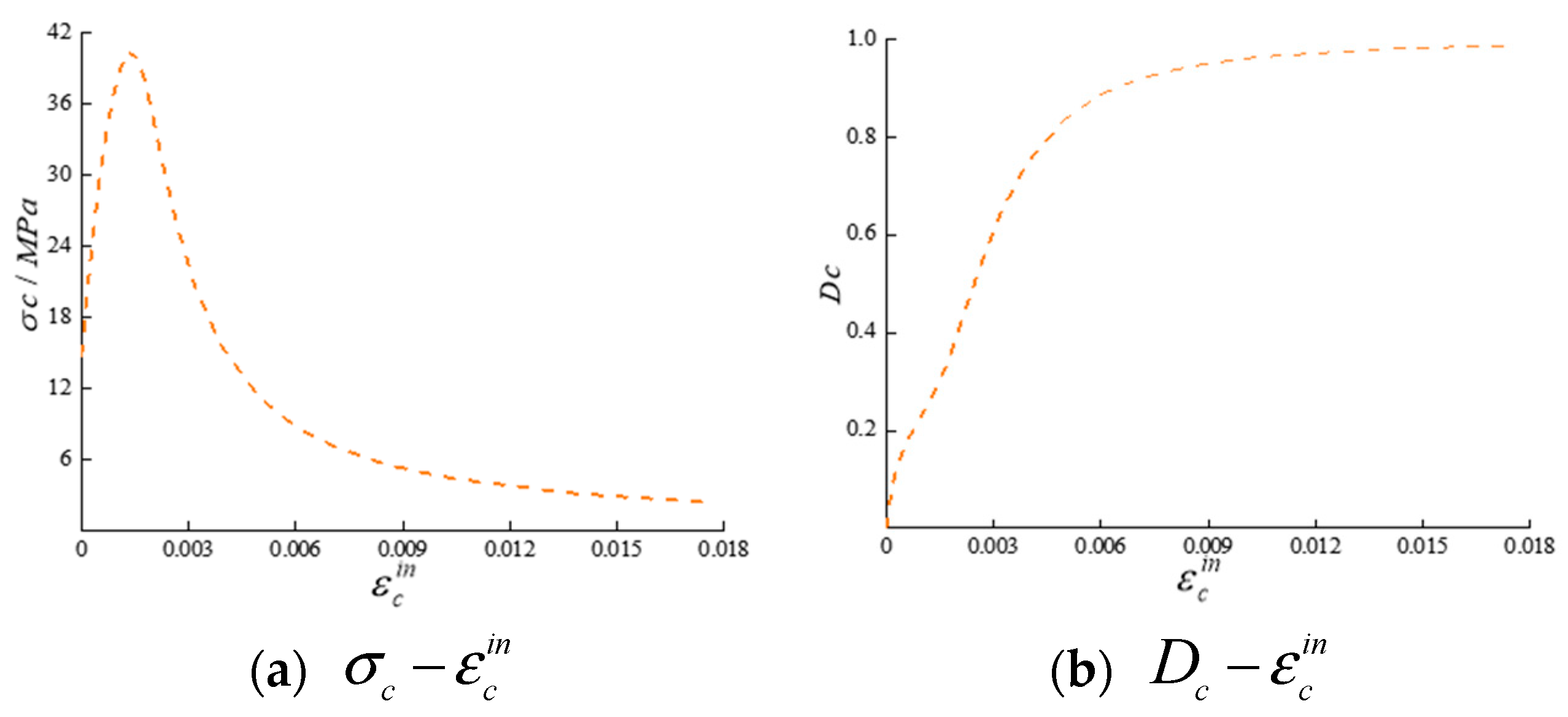


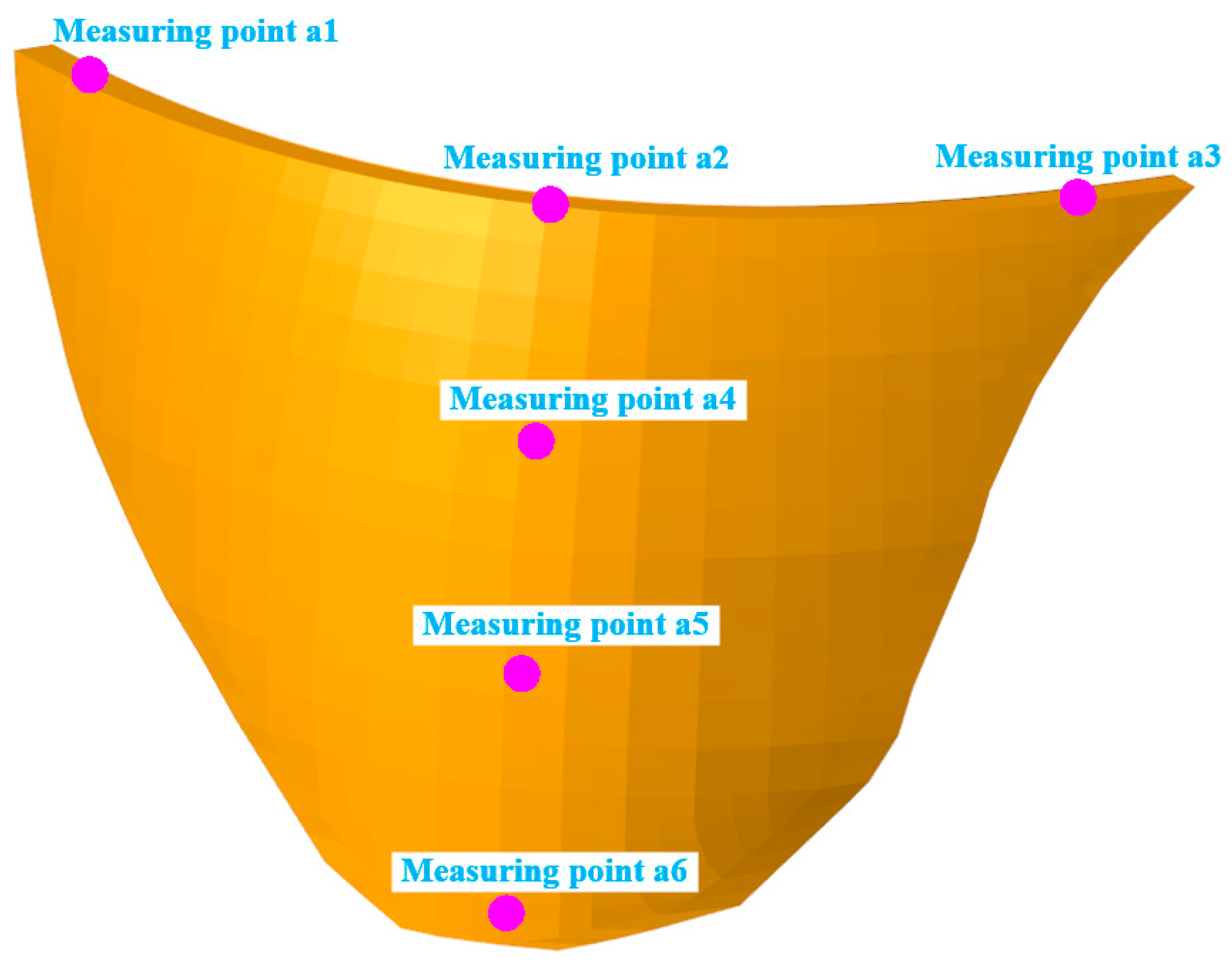



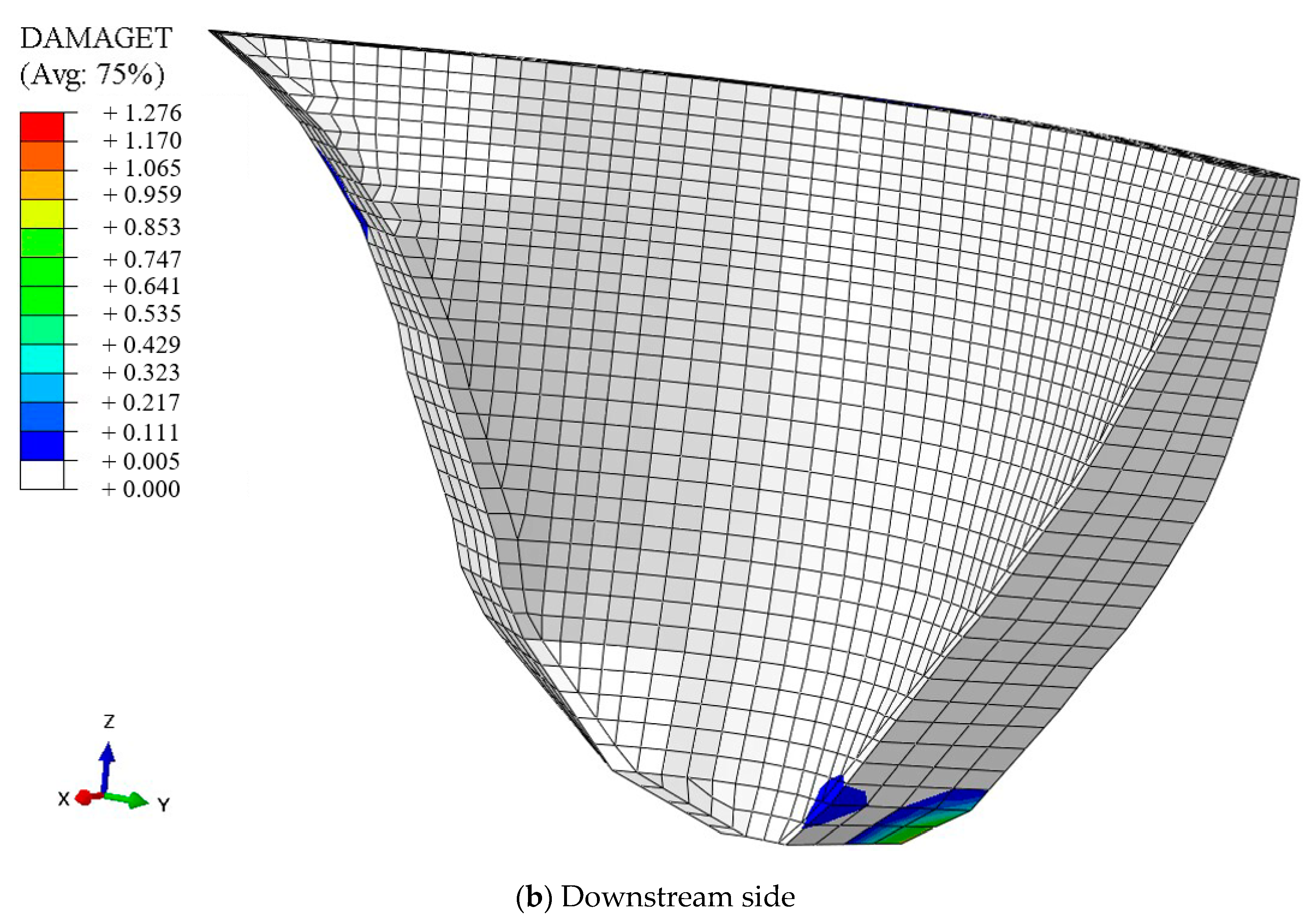
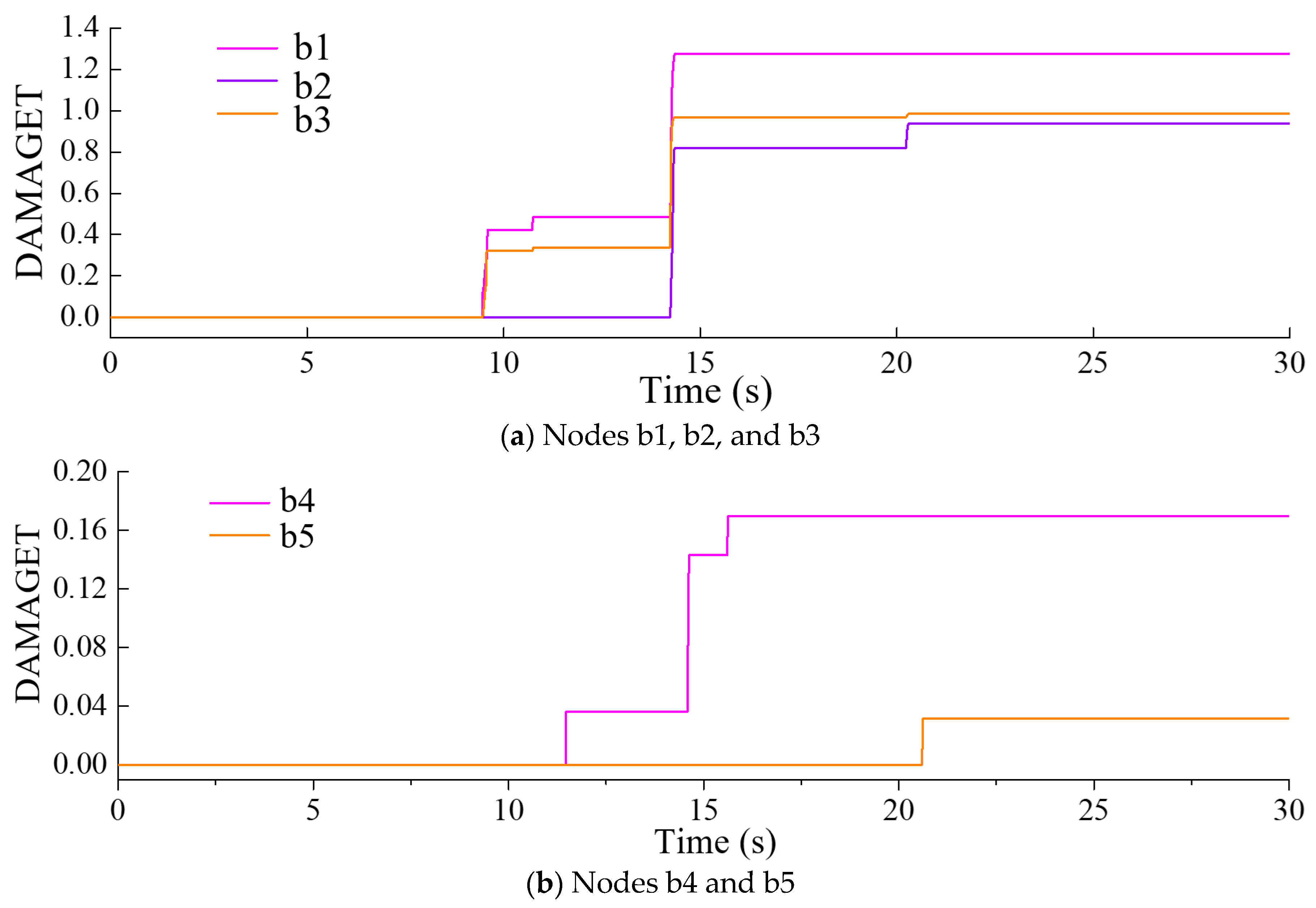


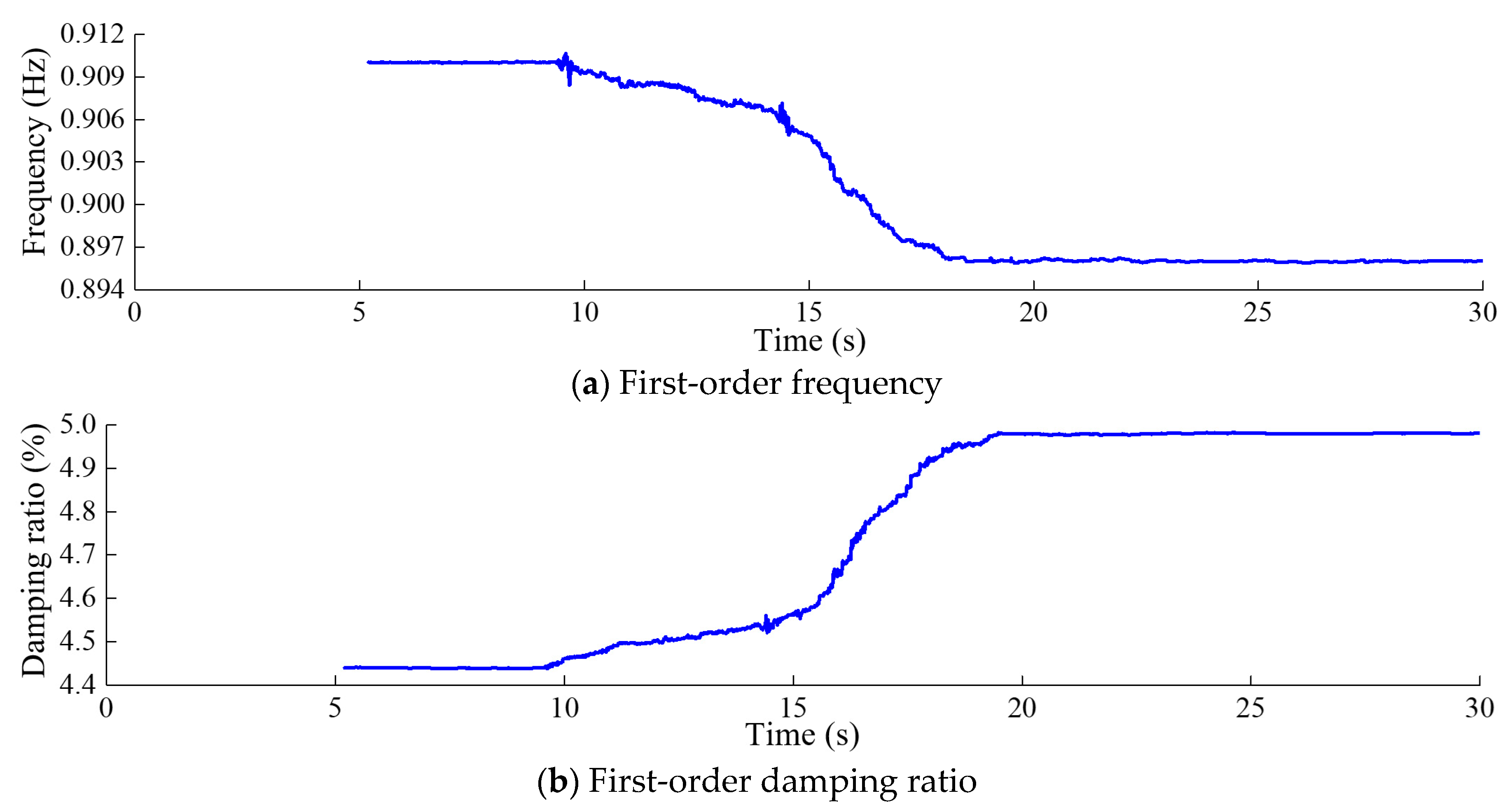
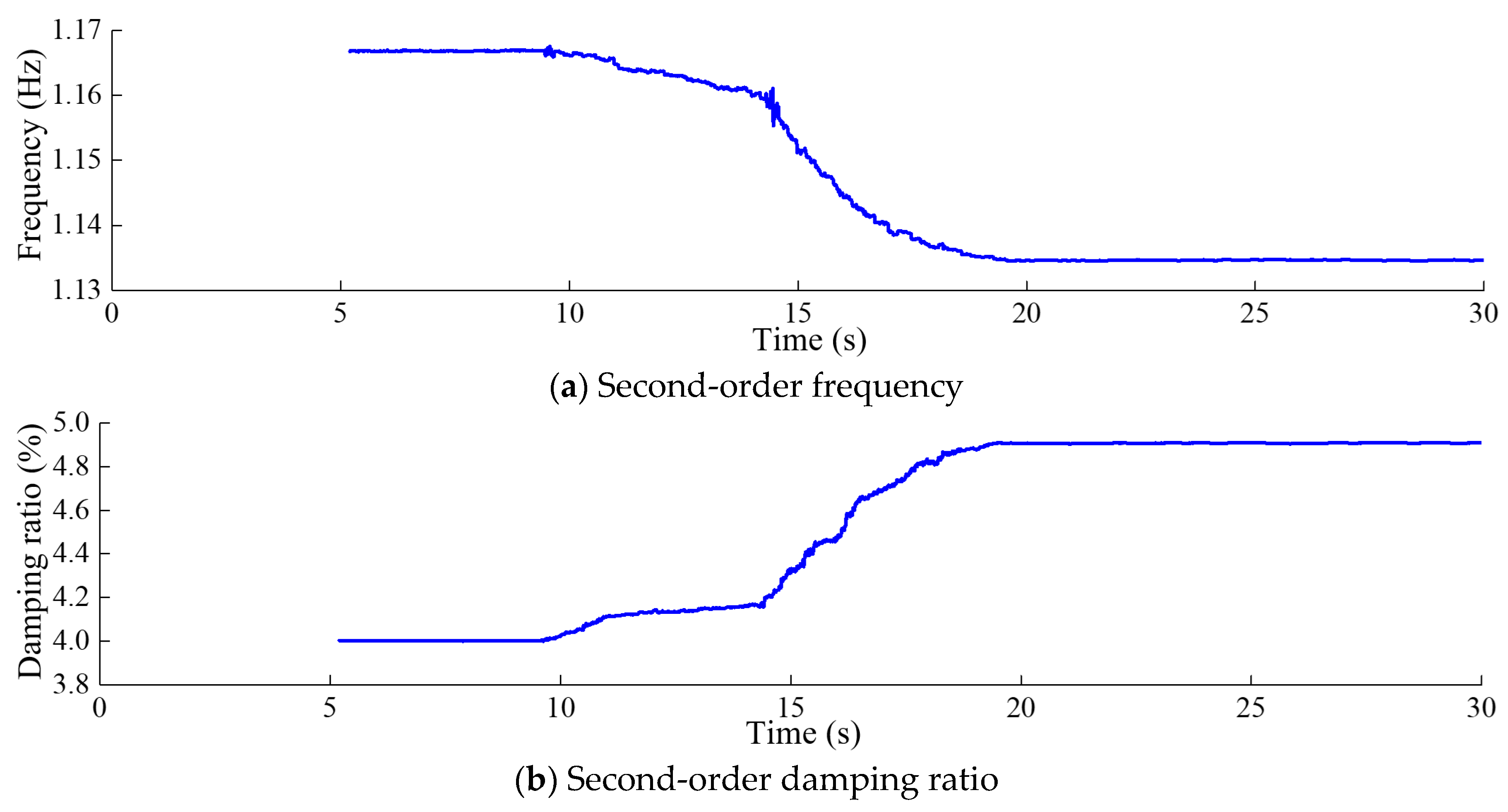



| Measuring Point | Elevation (m) | Measuring Point | Elevation (m) |
|---|---|---|---|
| a1 | 1885 | a2 | 1885 |
| a3 | 1885 | a4 | 1790 |
| a5 | 1695 | a6 | 1600 |
| Order | Identified Frequency (Hz) | True Frequency (Hz) | Relative Error (%) |
|---|---|---|---|
| 1 | 0.910 | 0.913 | 0.329 |
| 2 | 1.166 | 1.167 | 0.086 |
| 3 | 1.871 | 1.877 | 0.320 |
| 4 | 2.161 | 2.159 | 0.093 |
Disclaimer/Publisher’s Note: The statements, opinions and data contained in all publications are solely those of the individual author(s) and contributor(s) and not of MDPI and/or the editor(s). MDPI and/or the editor(s) disclaim responsibility for any injury to people or property resulting from any ideas, methods, instructions or products referred to in the content. |
© 2024 by the authors. Licensee MDPI, Basel, Switzerland. This article is an open access article distributed under the terms and conditions of the Creative Commons Attribution (CC BY) license (https://creativecommons.org/licenses/by/4.0/).
Share and Cite
Zhu, X.; Qiu, J.; Xu, Y.; Chen, X.; Xu, P.; Wu, X.; Guo, S.; Zhao, J.; Lin, J. Modal Parameter Recursive Estimation of Concrete Arch Dams under Seismic Loading Using an Adaptive Recursive Subspace Method. Sensors 2024, 24, 3845. https://doi.org/10.3390/s24123845
Zhu X, Qiu J, Xu Y, Chen X, Xu P, Wu X, Guo S, Zhao J, Lin J. Modal Parameter Recursive Estimation of Concrete Arch Dams under Seismic Loading Using an Adaptive Recursive Subspace Method. Sensors. 2024; 24(12):3845. https://doi.org/10.3390/s24123845
Chicago/Turabian StyleZhu, Xinyi, Jianchun Qiu, Yanxin Xu, Xingqiao Chen, Pengcheng Xu, Xin Wu, Shaolong Guo, Jicheng Zhao, and Jiale Lin. 2024. "Modal Parameter Recursive Estimation of Concrete Arch Dams under Seismic Loading Using an Adaptive Recursive Subspace Method" Sensors 24, no. 12: 3845. https://doi.org/10.3390/s24123845






